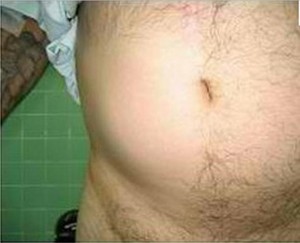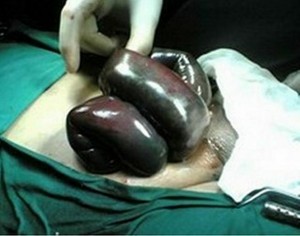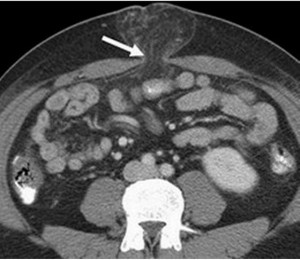Ventral Hernia – Pictures, Repair, Symptoms, Surgery, Types
What is a Ventral Hernia?
A hernia is an abdominal protrusion of an organ, tissue or any part of an organ through the structure that normally contains it. Hernia occurs due to structural defects in the integrity of the muscular wall combined with increased intra-abdominal pressure.
Hernias may develop before birth (congenital) because of incomplete closure of structures during embryonic development. It may also develop later because of certain factors that weaken the muscle fascia and increase abdominal pressure.
Ventral hernias are one of the classifications of abdominal hernia that occurs along the anterior, midline portion of the abdomen. However, certain ventral hernias may be seen in any location at the abdomen.
There are different locations and kinds of hernia which requires individual management.
Ventral Hernia at Various Locations
Lateral Ventral Hernia
Lateral Ventral hernia, otherwise called as Spigelian hernia, is a hernia that protrudes through the spigelian fascia, located between the rectus abdominis muscle (medially) and the semilunar line (laterally). The anatomical position of the hernia makes it called as lateral ventral hernia (on the lateral aspect of the anterior abdomen). It develops few inches from the midline aspect of the abdomen. Spigelian hernias are interparietal hernias, which means that they penetrate between the muscles of the abdomen and do not lie below the subcutaneous layer like other types of hernia. Spigelian hernias are small, occur mostly on the right side and they are rare. Spigelian hernias occur between 40 to 70 years of age.

Spigelian Hernia
Midline Ventral Hernia
Midline ventral Hernias are hernias that lie on the midline aspect of the abdomen. These include:
1. Epigastric Ventral Hernia or Supraumbilical Ventral Hernia
Epigastric ventral hernias are protrusions that occur through the linea alba, which is above the umbilicus (supraumbilical), located on the epigastric region of the abdomen. This area is between the umbilicus and the middle part of the ribcage.
2. Umbilical or Periumbilical Hernia
Umbilical hernias are protrusions located just beneath the umbilicus or near the navel. They involve protrusion of abdominal contents through the umbilical area. Umbilical hernias in newborns are a result of incomplete closure of the ligament that arises from the fetal umbilical cord. Umbilical hernias in adults are commonly seen in obese and pregnant women because of increase in the intra- abdominal pressure.
Incisional Hernia
Incisional hernias occur at the site of a previous surgical incision that did not heal adequately. About one third of patients undergoing abdominal surgeries develop this type of hernia. This type of hernia is difficult to manage because the tissue that will be repaired has already been weakened by previous surgery.

Various Locations of Middle Ventral Hernias And Incisional Hernia
Types
Ventral hernias can be subdivided according to their characteristics. These include:
Reducible
Reducible hernias are called so because the contents can be pushed back into the abdominal cavity, although temporarily because any increase in pressure can lead again to protrusion.

Reducible Hernia Being pushed by the Patient to Return Organs In Normal Position
Irreducible or Incarcerated Ventral Hernia
Irreducible hernias are those that cannot be returned to their original anatomical position with manipulation or they cannot be pushed in back into the abdominal cavity. Because of this, swelling may be present and cause the bulge to become red, dark pink, or purple. Incarcerated hernias may potentially lead to strangulation because of entrapment.
A CT-Scan of an Irreducible hernia: Note The Stricture on the Neck
Strangulated Ventral Hernia
Because of incarceration, hernias may eventually be strangulated. This is an emergency situation because strangulation decreases the blood flow to the organ and lead to tissue necrosis. Aside from severe abdominal pain, strangulated hernias often occur with other symptoms such as profuse sweating, rapid heart rate, increased swelling, glistening red bulge, nausea, vomiting, bloating, inability to pass stool, decrease in urine output, and very high fever. Because of possible necrosis, this type of hernia needs an immediate surgical action.

Strangulated Hernia Showing a Gangrenous Bowel
Recurrent Ventral Hernia
Recurrent hernias are those that reoccur, despite previous treatment. Recurrent hernias may be due to poor wound healing or poor hernia repair.
Ventral Hernia Pathophysiology
Ventral hernias occur due to weakening of the abdominal muscles and increase in intra-abdominal pressure. When these occur, abdominal contents, usually the intestines protrude from the abdominal wall. The weakened abdominal muscles are unable to contain the organs inside the cavity. Because of protrusion, they may become irreducible and cause the organs to be strangulated. These phenomenon decreases the blood and oxygen supply to the area and cause tissue necrosis or death. When these happen, the intestinal part may lose its function and cause inability to pass stools.
Symptoms
Symptoms of ventral hernia include:
- Visible and palpable bulge in the abdomen, becomes more obvious on standing
- Painless, some cases may be painful
- Swelling in the protrusion
- Heavy feeling on the hernia
When hernias become strangulated, the following symptoms may appear:
- profuse sweating
- rapid heart rate
- increased swelling
- glistening red bulge
- Nausea and vomiting
- Bloating
- inability to pass stool
- decrease in urine output
- very high fever
Causes
Ventral hernias may occur at birth or develop as the person grows. Congenital ventral hernias occur because of incomplete closure of the area and may be associated with teratogens (those substances or illnesses that affect development of the fetus). Hernias that develop at later years are a result of weakening of the muscles and increase in intra-abdominal pressure.
Weakening of muscles
Weakening of the muscles or membranes that contain abdominal organs is primarily congenital and may be inherited. Weakening also occur because of aging or degenerative diseases. Presence of Marfan’s syndrome, a condition affecting the connective tissue, also affects the flexibility and strength of muscles. Pregnancy and obesity also overstretches the muscles which lead to weakening. Lastly, poor nutrition and smoking also weakens the muscles in the abdomen.
Increased intra-abdominal pressure
Pressure inside the abdominal cavity is increased in conditions like pregnancy, ascites (presence of fluid inside the peritoneal cavity inside the abdomen) and hypertrophy of the prostate. Chronic coughing as a result of COPD, straining on defecation, and trauma to the abdomen can also lead to such. Heavy lifting and improper body mechanics during lifting also increases the pressure inside the abdomen.
Diagnosis
Imaging in the abdomen is the primary diagnostic test for ventral hernias. Computed tomography scans, specifically the Multidetector CT Scan allows precise imaging of the hernia, the contents and presence of complications such as strangulation.
Treatment
Management of ventral hernia starts from a thorough medical history taking and assessment. Treatment of ventral hernia involves non-invasive and invasive management, although surgery has been the most effective means of achieving it.
Some of the non-invasive medical managements of hernia include:
Mechanical Reduction
In cases or reducible and uncomplicated hernia, the contents are pushed back into the abdominal cavity.
Truss Placement
Truss is a firm pad held in the area of herniation to support it. It is held securely by a belt, which is worn daily and placed before rising from bed.
Repair
Herniorrhapy
Herniorrhapy is the repair of hernia where the surgeon opens the hernia sac, returns the herniated contents back to their original anatomical position and closes the muscles tightly over the area. Herniorrhapy can be done directly over the area or by laparoscopy. Laparoscopy is minimally invasive and allows for faster healing.
In cases of complicated hernias, the surgeon usually resects parts of the herniated organ such as those that are necrotic.
To reinforce the muscles around the area, mesh prosthesis is placed. Mesh products are sometimes placed over the area (anterior hernia repair) or under the affected area (posterior hernia repair). Placement of mesh is sometimes called tension-free hernia repair because it does not require too much pulling of the muscles together to be sutured. However, some sutures now also offer tension-free repairs such as Desarda and Lipton-Estrin sutures.
Tension free repairs by the use of mesh or sutures had proved evidence of lower rates of recurrence of hernias. However, they also cause more pain and infection.
Recovery from herniorrhapy usually takes two weeks for the wound to completely heal and patients can be discharged from the hospital after 24 to 48 hours of surgery.
To prevent recurrence of hernia, patients are advised to refrain from heavy lifting and increasing intra-abdominal pressure. Patients are instructed on proper splinting during coughing and also to increase fiber to prevent constipation and straining in stools.
Ventral Hernia Mesh Types

Sample Mesh Used in Ventral Hernia Repair
Mesh acts as scaffolding for new tissue growth to prevent tension on the abdominal wall. Mesh products are available in various sizes and may be cut according to the surgeon’s preference. They also occur in various types which include:
Multilayered Mesh
This type conforms to the body and improves scar tissue formation
Human Dermis
This type is made from human skin which reduces operation time and is more cost-effective. It also prevents rejection of the mesh because it is naturally made from human skin.
Absorbable
These are lightweight mesh products which are absorbed by the tissues. It is also more flexible to allow movement of the organ.
Complications
Complications of ventral hernia include effects from strangulation and post-operative complications such as:
- Bowel obstruction
- Incarceration
- Strangulation
- Hemorrhage
- Mesh rejection- This is often seen as a swelling on the surgical site. Mesh rejection requires removal of the mesh.
